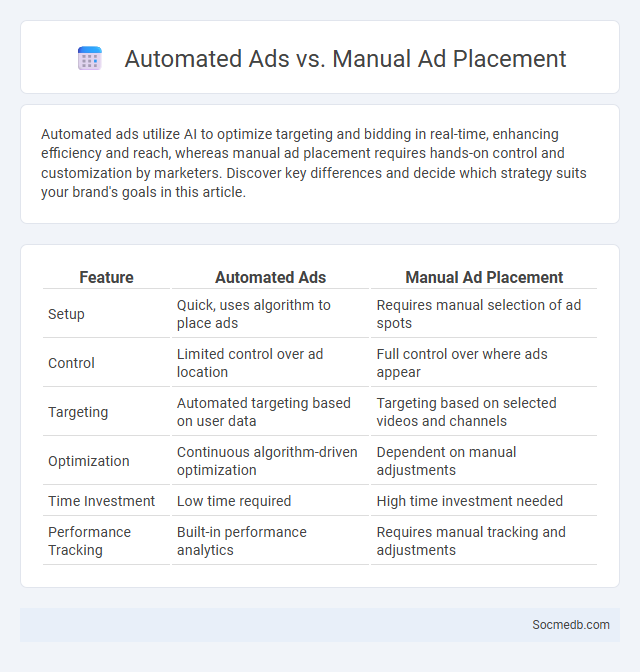
Photo illustration: Automated Ads vs Manual Ad Placement
Automated ads utilize AI to optimize targeting and bidding in real-time, enhancing efficiency and reach, whereas manual ad placement requires hands-on control and customization by marketers. Discover key differences and decide which strategy suits your brand's goals in this article.
Table of Comparison
| Feature | Automated Ads | Manual Ad Placement |
|---|---|---|
| Setup | Quick, uses algorithm to place ads | Requires manual selection of ad spots |
| Control | Limited control over ad location | Full control over where ads appear |
| Targeting | Automated targeting based on user data | Targeting based on selected videos and channels |
| Optimization | Continuous algorithm-driven optimization | Dependent on manual adjustments |
| Time Investment | Low time required | High time investment needed |
| Performance Tracking | Built-in performance analytics | Requires manual tracking and adjustments |
Introduction to Online Advertising Strategies
Online advertising strategies leverage various social media platforms to target specific audiences with precision using data analytics and user behavior insights. Effective campaigns incorporate keyword optimization, engaging visuals, and call-to-action elements to maximize conversion rates and brand visibility. You can enhance your business growth by understanding platform-specific features like Facebook Ads Manager, Instagram Stories promotions, and LinkedIn Sponsored Content.
What Are Automated Ads?
Automated ads use artificial intelligence and machine learning to create, manage, and optimize your social media advertising campaigns with minimal manual input. These ads dynamically adjust targeting, bidding, and creative elements based on real-time data to maximize performance and return on investment. Your business benefits from improved efficiency and enhanced audience reach through automated ad processes on platforms like Facebook, Instagram, and Google.
Manual Ad Placement Explained
Manual ad placement in social media allows advertisers to choose specific platforms, devices, and audience locations where their ads will appear, enhancing targeted reach and campaign efficiency. This approach provides greater control over budget allocation and performance tracking compared to automatic placements, making it ideal for businesses aiming to optimize ROI through precision targeting. By selecting placements manually, advertisers can avoid less relevant channels and focus resources on high-converting audience segments within Facebook, Instagram, Twitter, and LinkedIn.
Key Differences: Automated Ads vs Manual Ad Placement
Automated ads on social media leverage algorithms and AI to optimize bidding, targeting, and placement in real-time, maximizing reach and efficiency based on data-driven insights. Manual ad placement requires You to have direct control over audience selection, budget allocation, and scheduling, allowing for precise customization but demanding more time and expertise. The key differences lie in automation's scalability and adaptability versus manual control's specificity and hands-on management.
Impact on Ad Revenue: Automated vs Manual
Automated social media advertising leverages AI algorithms to optimize ad placements and targeting, resulting in higher click-through rates and increased ad revenue compared to manual methods. Manual social media advertising requires human input for campaign management, often leading to slower adjustments and less efficient budget allocation. Data shows businesses using automated ad systems experience up to a 30% boost in overall ad revenue due to improved precision and scalability.
Pros and Cons of Automated Advertising
Automated advertising on social media platforms enhances targeting precision by leveraging AI algorithms to analyze user behavior and deliver personalized ads, increasing your campaign's efficiency and ROI. However, it can also lead to reduced human oversight, potentially causing ads to misalign with brand values or target inappropriate audiences. Balancing automation with strategic human input ensures that your social media advertising remains both effective and reflective of your brand identity.
Pros and Cons of Manual Ad Placement
Manual ad placement on social media offers precise control over targeting specific demographics, ensuring your ads reach the most relevant audience and potentially improving engagement rates. However, this approach can be time-consuming and requires extensive expertise to optimize bids and placements effectively, which may limit scalability for smaller teams. You must weigh the benefits of customization against the challenges of managing campaigns without automation tools.
Ad Revenue Optimization Techniques
Maximizing your social media ad revenue requires leveraging advanced targeting algorithms and real-time analytics to reach high-intent audiences efficiently. Utilizing A/B testing on creatives and call-to-actions helps refine campaigns, increasing click-through rates and conversion metrics. Integrating automation tools for bid management and budget allocation ensures optimal spend distribution across platforms for consistent revenue growth.
Choosing the Right Approach for Maximum Revenue
Selecting the right social media strategy significantly impacts your revenue growth by targeting platforms where your audience is most active. Leveraging data-driven insights and tailored content increases engagement and conversion rates effectively. Focus on consistent brand messaging and timely interactions to maximize customer loyalty and sales performance.
Future Trends in Ad Placement and Revenue
Social media platforms are increasingly leveraging AI-driven algorithms to deliver hyper-personalized ad placements, enhancing user engagement and ad effectiveness. The rise of augmented reality (AR) and virtual reality (VR) ads is expected to generate significant revenue growth by offering immersive brand experiences. Programmatic advertising and real-time bidding will dominate future revenue streams, optimizing ad spend through precise targeting and performance analytics.
 socmedb.com
socmedb.com